



Throughout the last few years, the world has transitioned from close contact activities to creating work and school environments online. Students worldwide had to navigate online modules and peer communication from their homes. During this time, many students could dedicate effort to their schoolwork when it was convenient and found an academic and personal life balance they enjoyed. Now, we’re seeing many students back on campus and some institutions are reinstating their pre-pandemic practices.
The switch from campus to computer was sudden and drastic, but many students were able to keep pace and complete each semester without a hitch. Still, others struggled to balance coursework and didn’t enjoy time away from friends, instructors, and campus life.
Higher education institutions are still navigating the switch from physical learning to digital learning (and back again!). As more students enroll in online courses, higher education institutions face a retention crisis that threatens initiatives and student goals. Although online classes let students work from anywhere at any time, virtual students lose peer connections and academic support. Many students have become unsatisfied with their education and seek alternative options for a more rewarding experience.
Now more than ever, understanding your students and filling the gaps to create an enriching environment is essential. Student surveys and course evaluations can give insight into where students struggle, what you can do to bridge the gaps, and whether you’re working toward your institution’s goals.
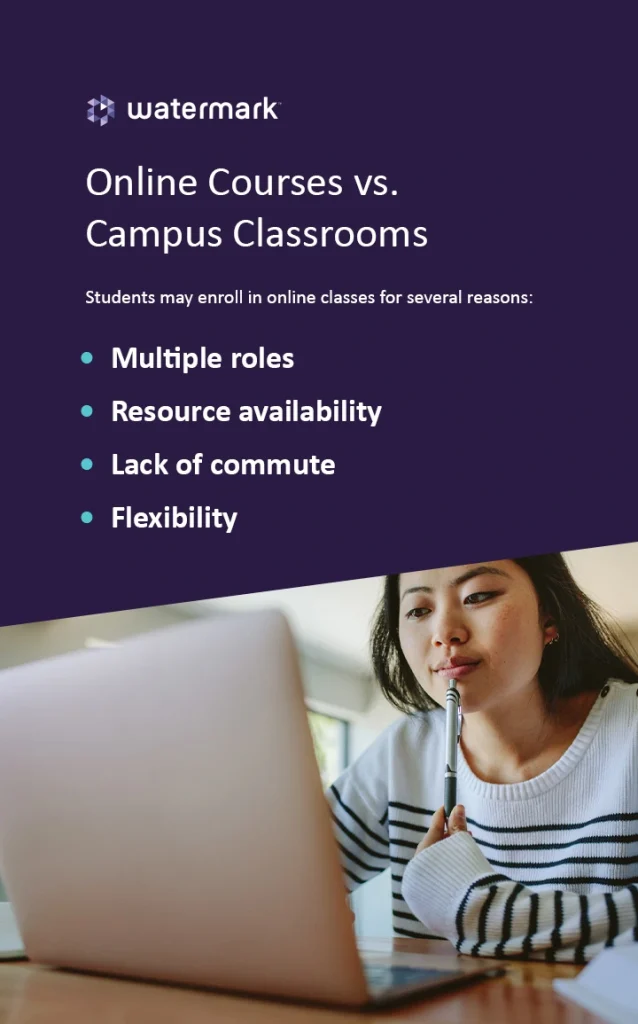
Although online and campus courses can provide students with an exceptional learning experience, there are some fundamental differences between them. Many students enroll in online courses because of the flexibility they can gain in their schedules. While campus classes meet at specific times and days of the week, online courses typically let students complete work when it’s convenient for them. Although some virtual classrooms operate through video class sessions, many are a collection of online resources and due dates students can review whenever necessary.
Students may enroll in online classes for several reasons:
Despite the convenience of online education, students and institution leaders must combat other obstacles, such as the impact of online learning on student performance. Using an online course feedback form and an online instructor evaluation survey, you can establish where your online courses can improve and compare the performance of your virtual and in-person students.
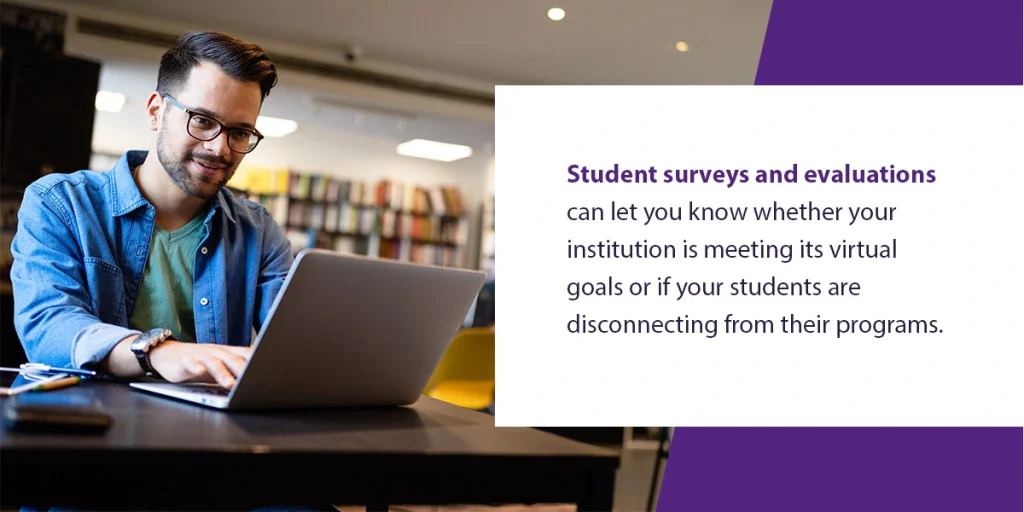
Engaging and motivating virtual students with their studies can be a challenge. Keeping the curriculum creative and interactive may take more effort compared to in-person classes. When offering online courses, instructors must set realistic expectations for students and themselves.
Many students participate more in campus classes than online classes, and integrating a weekly schedule can encourage students to stay on track and reach out for help when they fall behind. Constant communication and making instructors readily available to virtual students also reduces the guesswork for students to complete their work and continue towards success.
Virtual instructors may also need to work harder to foster a sense of community among students. Building and encouraging a student network can guide them toward success. Without communication and collaboration, students lose a valuable aspect of their higher education and reduce the chances of making lasting connections with their professors, peers, staff members, and success team.
Student surveys and evaluations can let you know whether your institution is meeting its goals or if your students are disconnecting from their programs. You may need to adjust your evaluation strategy for online classes, but you shouldn’t stray from your campus initiatives. Both in-person and virtual classrooms should reflect your goals regarding student retention and motivation. Keeping your students engaged and enrolled in their studies until their completion will benefit your school and enable you to set more goals in the future.
When students feel a sense of belonging, participation, motivation, and support, they perform better, leading to higher retention. Creating an inclusive environment in virtual classrooms is key to student success. Online projects and learning can be more engaging for students if the information is presented in the right way.
Developing an online course evaluation system will help keep data organized and let you track progress. As you welcome more students and work to motivate current ones, you can use student surveys to address concerns and provide a worthwhile educational experience.

Many higher education institutions and colleges are seeing an increase in virtual students with less funding to accommodate them. After realizing the accessibility and flexibility of virtual classes, many students previously on campus are filling their schedules with virtual courses. When classes fill with more students, it becomes harder for students to connect with their instructors, especially when they attend classes online. A lack of human connection leads many students to invest in other institutions where they can have more interaction and collaboration.
Online courses could benefit from introducing more collaborative projects where students can interact and dive into deep work that produces rewarding results. When small groups of students work together and receive feedback on their portion of the project, they see instructors appreciate their hard work and are invested in their growth. This also encourages peer collaboration that can give virtual classes the sense of community that campus classes have.
Online courses offering complete flexibility can seem like a dream come true for some students, but others struggle to devise a schedule and manage their workload. Virtual classes may need more structure and design than in-person classes. The lack of interaction between students and an instructor can cause virtual students to see answering or asking questions as unimportant and lose the opportunity to get academic support.
Whereas campus classes can adjust course schedules as students show interest in complex topics or need more time to complete assignments, virtual classrooms tend to stay on schedule as students work at whatever pace suits them. Keeping an accurate schedule helps students know when to dedicate time to materials and keeps them engaged with learning throughout the semester.
Students who procrastinate may find more work than they can handle at the end of the semester. Incomplete or failing grades could prompt students to drop their online courses or pursue education from another institution. Paired with the inability to contact an instructor or success team member, some students flounder in their coursework without realizing the importance of asking for assistance.

The goal of your surveys should always be to aid in reporting and analysis. Course evaluations are a great way to dissect the problems students have and begin understanding what your institution can do to give them a more enriching experience. Regardless of the course types students enroll in, you want to avoid some practices and follow others when creating your surveys.
Course evaluations need to be direct and address a single criterion at a time. Questions addressing more than one item can be confusing or difficult to answer. If a student feels half of a question is true and the other half is false, they won’t be able to answer accurately, and you won’t get actionable results.
For example, your course evaluation may have a multiple choice format, ranging from ‘very satisfied’ to ‘very unsatisfied’ answer options. A survey question such as “Class materials were affordable and accessible, and supplemental resources were provided at the campus library” should be broken into two separate questions on this survey. One student may feel course materials were expensive, but library resources were exceptional. Another student may have thought materials were affordable but never spent time in the library. Both students may answer this question as ‘slightly satisfied,’ but you cannot know which part of the statement applies.
Keep questions short and concise. Students will complete multiple surveys throughout the last few days of the semester, and long chunks of text may be intimidating for some. Students may not read the entire question, fill in random answers to avoid reading the text, or neglect the survey entirely, leaving you with fewer results to work with.
If you administer the same survey to every student, you must ensure the questions apply to every department and class. If you want to dissect a program or department, administer a targeted survey to those enrolled in those courses.
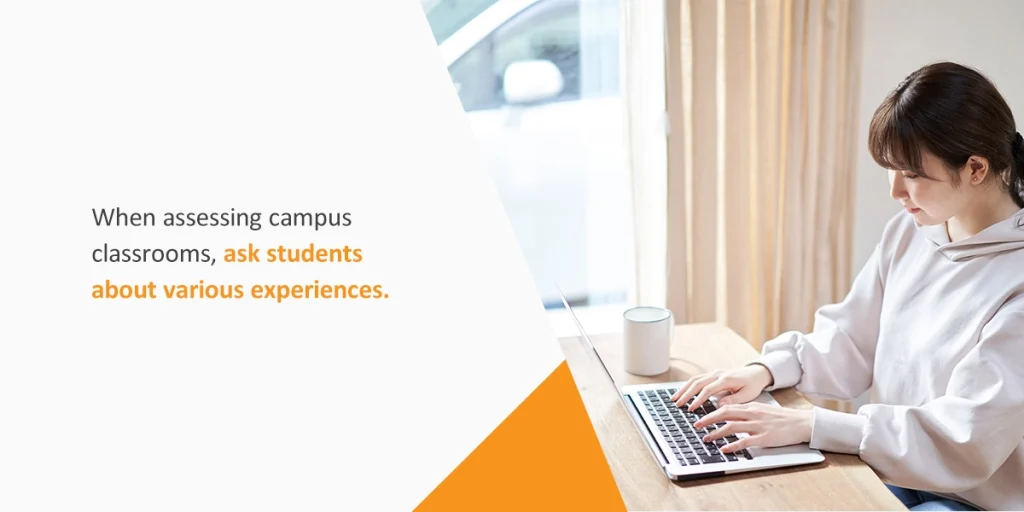
Students who enroll in in-person classes will have a different educational experience than those who register for online courses. Students on campus have external factors affecting their academics, such as campus parking, library accessibility, resource center availability, and classroom organization and cleanliness.
Finding the best course evaluation survey questions comes down to your objective. You should always define your goals before the survey and determine if you want to focus your efforts toward teaching methods, program trends, student motivation, or anything else. You can create survey questions with more clarity and purpose when you define your objectives.
When assessing campus classrooms, ask students about various experiences. You may want to gather insight about campus life to develop a sense of community or understand how motivated your students feel. Perhaps you’re trying to discover why one department has a high student completion rate while another is struggling. Campus life can affect student motivation, engagement, and retention, so it’s important to ask questions through various surveys about all scopes to gauge the complete picture.
Questions you could consider for your survey regarding student classroom experiences include:
Once you establish your course evaluations, plan to keep them for a while to track your progress. Keeping the same questions for multiple semesters can help you organize your data and identify areas that are improving, staying the same, or declining.

Campus life is just as crucial to a student’s success as academics, and their sense of community can affect their performance. Self-assessment evaluations and campus life surveys help gauge student motivation and whether your campus community is welcoming and diverse.
Campus life surveys could discuss:
Gathering information about the motivation of your students can depict how many of your students are pursuing education for intrinsic or extrinsic purposes. This motivation will help them finish their programs and guide them toward success. If your students don’t feel motivated, you know to set your sights on creating an environment and curriculum that engages them and rewards them for hard work.
Self-assessment questions include:

Virtual students won’t have the same campus experience as in-person students. Online students who live out of the area won’t be able to interact with peers as often, join as many clubs, or participate in community events. Although campus life may not affect their learning, other factors affect whether they feel satisfied with their degrees or programs.
Students who enroll in online classes need a schedule that works for them. Although there is freedom to an online course, dedicating time to putting the best foot forward can be challenging for some. It can be easy to think of an online class as one that does not require as much effort or intensity because there is less engagement, interaction, and collaboration.
Students taking virtual classes could benefit from additional attention and resources that identify pain points in their departments and encourages them to interact with their peers and success team. An online course evaluation can detail how virtual students feel about coursework, instructors, and resources compared to in-person students.
Online learning survey questions for students could include:
Online course feedback questions can be a great way to identify where your institution is lacking in virtual academics. By administering a course evaluation online for virtual students, you make it easy for them to give you insight into their needs, goals, and experiences. You can use your data to understand the impact of online learning on students and evaluate their motivation levels to determine how to create a more enriching experience.
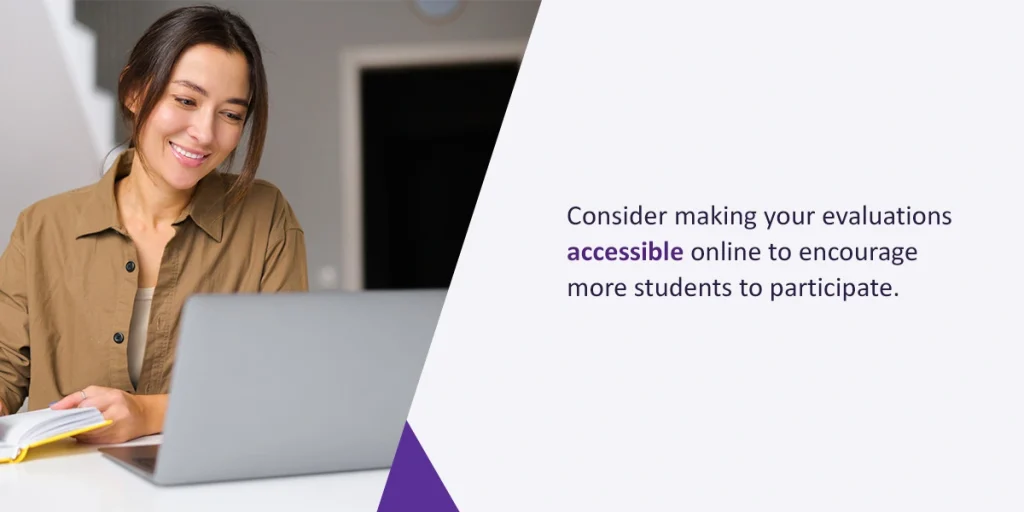
Your survey responses and data should drive meaningful change. Try to reach as many students as possible and obtain accurate answers depicting real student experiences. Consider making your evaluations accessible online to encourage more students to participate. Placing your evaluation online and encouraging students to complete it on their own time anonymously can give you more responses than expecting them to fill out and return written answers. After collecting data, devise strategies to implement your ideas.
Online course feedback examples could include students depicting a lack of virtual student resources, unorganized course materials, or loose connections with peers. Virtual students may struggle to connect with their studies because they feel unprepared in their field, don’t have a point of contact for help, or want a more personal education than they feel they’re receiving. Institution leaders can use this data to reflect on ways to address and alleviate these concerns. Perhaps you dedicate resources towards developing a new virtual resources department, discuss course guideline changes with department heads, or introduce a hybrid curriculum for students to meet for some classes to interact with peers.
Students on campus may identify a lack of classroom organization, acknowledge a frustrating student parking situation, or express a heightened interest in a sense of community. You can use this feedback to create student clubs, organize community volunteer programs, dedicate funds to building a parking garage, or meet with instructors to discuss their classroom dynamics.
There are plenty of creative ways to use end-of-semester data to engage students with their studies, even before making a campus-wide change. For example, students can create e-Portfolios that highlight what they’ve learned and encourage them to make connections to their future careers. An e-Portfolio can become a collection of student accomplishments and a progress tracker of institution initiatives and student goals.
At Watermark, people are at our center. We know technology can streamline data collection and aid in the learning process, but people need more than their computers to feel satisfied with their education. A student evaluation of online courses details how they perform virtually compared to on campus and whether they’re getting the fulfilling experience they seek. You can use our software to distribute your evaluations and efficiently track student responses.
Watermark Course Evaluations & Surveys turns student responses into actionable insights you can use to improve learning and teaching experiences. Our automated distribution process lets your administrators track trends over time easily and quickly. Use your data to create a curriculum strategy that guides students to success.
Request a demo of Course Evaluations & Surveys and create a satisfying and motivating experience for your students that promotes lifelong learning.
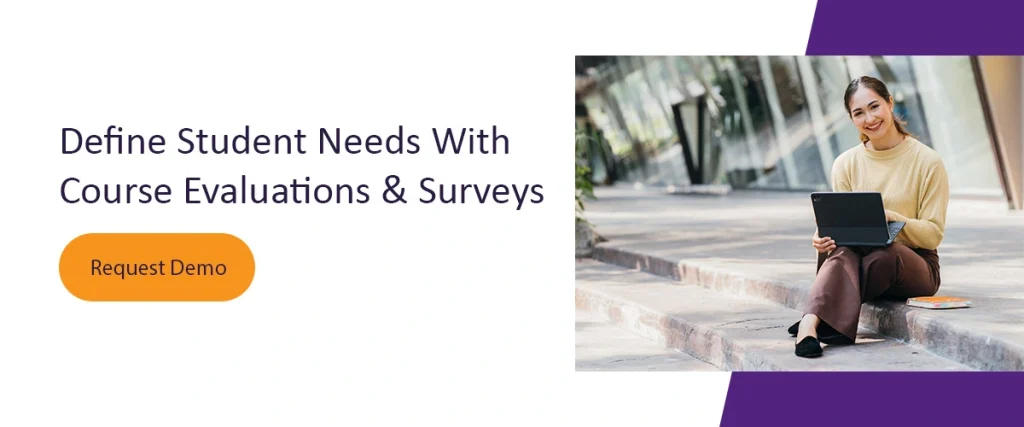
























































































































































































































































































































































































Submit this form to schedule a meeting with one of our reps to learn more about our solutions. If you need customer support instead, click here.